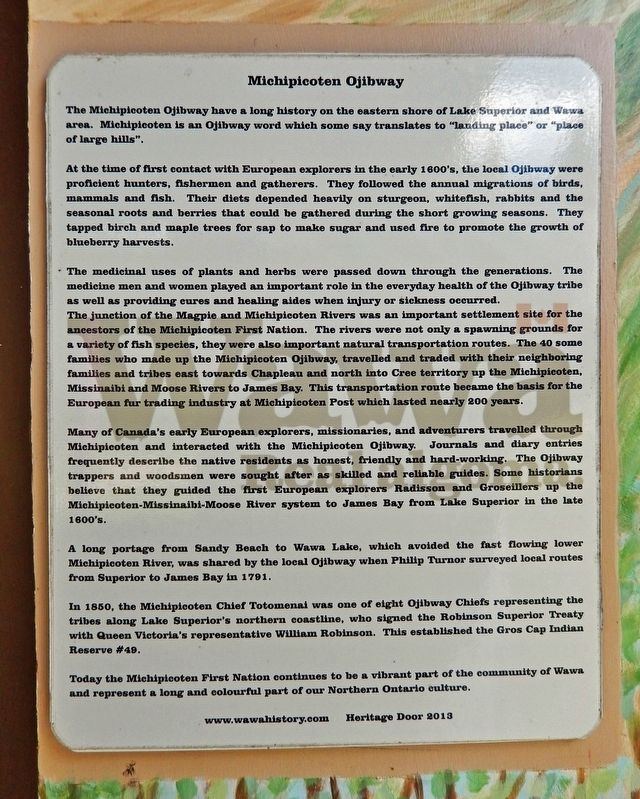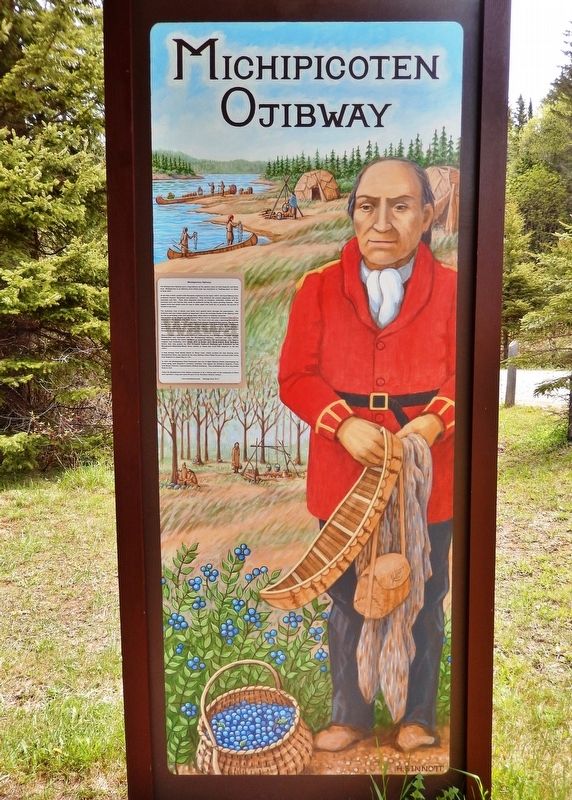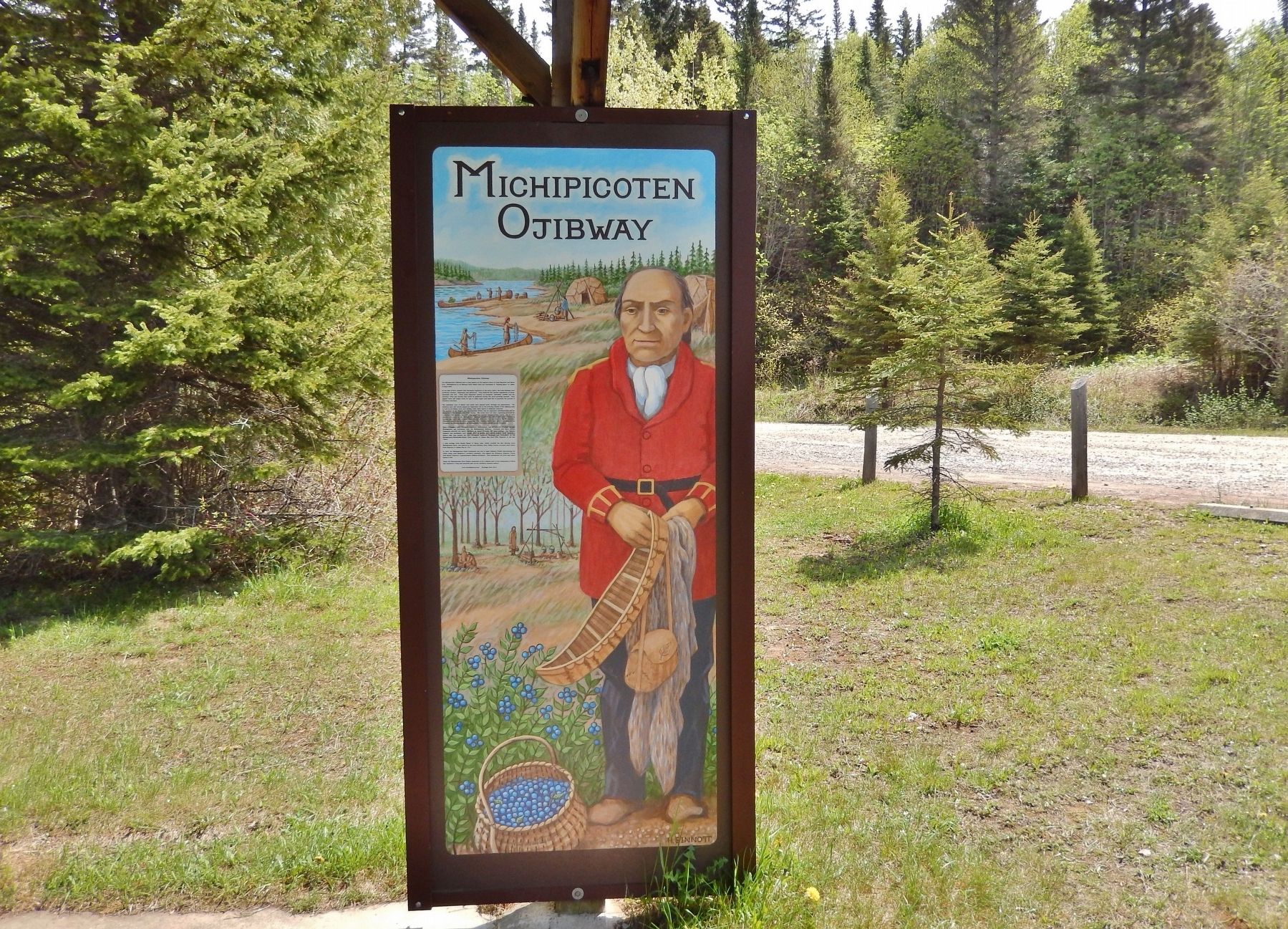Wawa in Algoma District, Ontario — Central Canada (North America)
Michipicoten Ojibway
The Michipicoten Ojibway have a long history on the eastern shore of Lake Superior and Wawa area. Michipicoten is an Ojibway word which some say translates to "landing place" or "place of large hills".
At the time of first contact with European explorers in the early 1600's, the local Ojibway were proficient hunters, fishermen and gatherers. They followed the annual migrations of birds, mammals and fish. Their diets depended heavily on sturgeon, whitefish, rabbits and the seasonal roots and berries that could be gathered during the short growing seasons. They tapped birch and maple trees for sap to make sugar and used fire to promote the growth of blueberry harvests.
The medicinal uses of plants and herbs were passed down through the generations. The medicine men and women played an important role in the everyday health of the Ojibway tribe as well as providing cures and healing aides when injury or sickness occurred.
The junction of the Magpie and Michipicoten Rivers was an important settlement site for the ancestors of the Michipicoten First Nation. The rivers were not only a spawning grounds for a variety of fish species, they were also important natural transportation routes. The 40 some families who made up the Michipicoten Ojibway, travelled and traded with their neighboring families and tribes east towards Chapleau and north into Cree territory up the Michipicoten, Missinaibi and Moose Rivers to James Bay. This transportation route became the basis for the European fur trading industry at Michipicoten Post which lasted nearly 200 years.
Many of Canada's early European explorers, missionaries, and adventurers travelled through Michipicoten and interacted with the Michipicoten Ojibway. Journals and diary entries frequently describe the native residents as honest, friendly and hard-working. The Ojibway trappers and woodsmen were sought after as skilled and reliable guides. Some historians believe that they guided the first European explorers Radisson and Groseillers up the Michipicoten-Missinaibi-Moose River system to James Bay from Lake Superior in the late 1600's.
A long portage from Sandy Beach to Wawa Lake, which avoided the fast flowing lower Michipicoten River, was shared by the local Ojibway when Philip Turnor surveyed local routes from Superior to James Bay in 1791.
In 1850, the Michipicoten Chief Totomenai was one of eight Ojibway Chiefs representing the tribes along Lake Superior's northern coastline, who signed the Robinson Superior Treaty with Queen Victoria's representative William Robinson. This established the Gros Cap Indian Reserve #49.
Today the Michipicoten First Nation continues to be a vibrant part of the community of Wawa and represent a long and colourful part of our Northern Ontario culture.
Erected 2013 by Wawa Heritage Doors.
Topics. This historical marker is listed in these topic lists: Agriculture • Exploration • Native Americans • Waterways & Vessels. A significant historical year for this entry is 1791.
Location. 47° 57.554′ N, 84° 49.673′ W. Marker is in Wawa, Ontario, in Algoma District. Marker can be reached from Scenic High Falls Road (Pinewood Drive), 3.6 kilometers west of Trans-Canada Highway (Provincial Highway 17). Marker is located at the Magpie Falls Scenic Overlook. Touch for map. Marker is in this post office area: Wawa ON P0S 1K0, Canada. Touch for directions.
Other nearby markers. At least 8 other markers are within 3 kilometers of this marker, measured as the crow flies. Reverend Father Dominique Chardon du Ranquet (a few steps from this marker); Scenic High Falls Park Dedication (a few steps from this marker); Jack Legarde (a few steps from this marker); Glenn Gould (a few steps from this marker); Wawa's Logging Heritage (within shouting distance of this marker); Professor Lewis Agassiz (1807-1873) (approx. 2 kilometers away); Alexander Young Jackson (1882-1974) (approx. 2.1 kilometers away); Michipicoten Scenic Lookout (approx. 2.1 kilometers away). Touch for a list and map of all markers in Wawa.
Also see . . .
1. Earliest Inhabitants of the Michipicoten River
.
The earliest records of the Europeans tell us that they met with two Ojibway tribes inhabiting the northeast corner of Lake Superior, an inland group and a coastal group. The inland group was identified as the “Tetes de Boules” or “Gens de Terre”, and later became known as the “Big Head Ojibway”. The coastal people were the “Michipicoute” also known as “Gens du Lac”. These tribes were connected by marriage and trade. At the height of the fur trade from the 17th to 20th centuries, many Europeans who came to the region took Ojibway wives and their descendants lived the native way of life making a large part of their livelihood by fishing and trading furs with the Hudson’s Bay Company and other settlers.(Submitted on March 14, 2023, by Cosmos Mariner of Cape Canaveral, Florida.)
2. Michipicoten First Nation.
The Michipicoten First Nation is an Ojibway First Nation band government in Northern Ontario, located near Wawa. Members of the community have lived at the mouth of the Michipicoten River since before the first arrival of European settlers to the area. The Michipicoten went through several forced moves during the 19th and 20th centuries, causing significant disruption to the community. Members of the First Nation concluded a historic land agreement with the governments of Canada and Ontario in January 2008, after a successful referendum.(Submitted on March 14, 2023, by Cosmos Mariner of Cape Canaveral, Florida.)
3. Michipicoten First Nation: Ojibway-Anishinaabe, Wawa Area, Northern Ontario, Canada.
(Youtube video for "Michipicoten First Nation.”) (Submitted on March 14, 2023, by Cosmos Mariner of Cape Canaveral, Florida.)
4. Wawa Heritage Doors - portals into our past!.
"Wawa's Heritage Doors are a truly creative and effective way to combine history and art in a visually attractive cultural display for both Wawa residents and visitors to enjoy!"(Submitted on March 15, 2023, by Cosmos Mariner of Cape Canaveral, Florida.)
Credits. This page was last revised on March 21, 2023. It was originally submitted on March 14, 2023, by Cosmos Mariner of Cape Canaveral, Florida. This page has been viewed 271 times since then and 56 times this year. Photos: 1, 2, 3. submitted on March 14, 2023, by Cosmos Mariner of Cape Canaveral, Florida.


